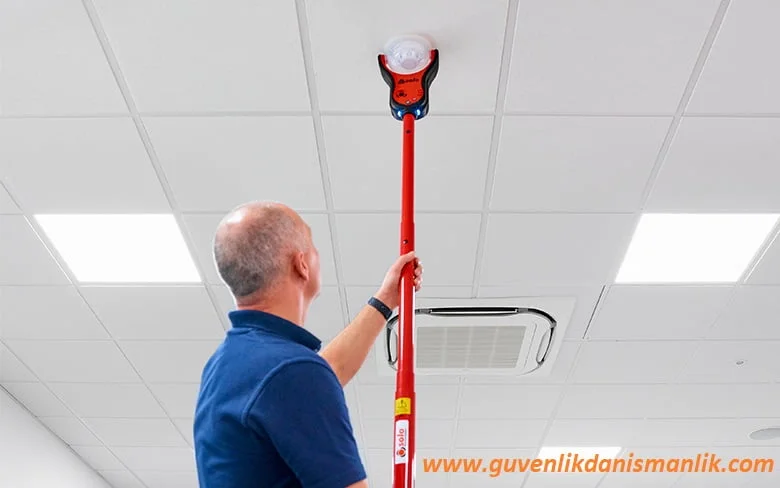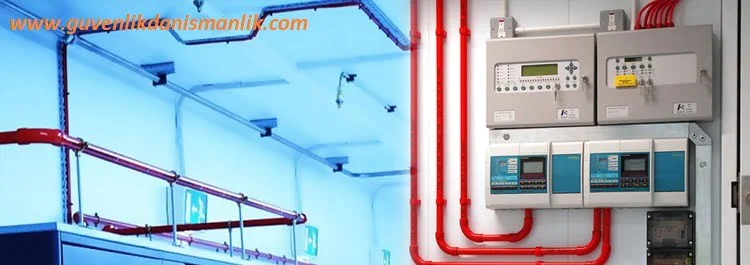Fire detection systems are used to provide early warning and quickly detect fires. It is crucial that these systems function properly, so regular maintenance and testing are important. Fire detection system maintenance may include the following steps:
- Detectors: Fire detection system detectors activate the system when a fire occurs. It is important to ensure that the detectors are properly placed and functioning correctly. Detectors need to be cleared of any dust or debris.
- Control Panel: The fire detection system control panel ensures that the system operates correctly. The control panel needs to be regularly checked, tested, and maintained. Additionally, the battery and other components in the control panel need to be regularly replaced.
- Power Supply: The power supply for the fire detection system provides power to the system and can be used as an emergency backup power source. The power supply needs to be regularly checked and tested.
- Cable Connections: The fire detection system cable connections need to be regularly checked and tightened.
- Alarms: Fire detection system alarms help people respond to a fire. It is important to ensure that alarms are properly placed and functioning correctly.
- Test Equipment: The system needs to be regularly tested and test equipment can be used for this purpose.
- Maintenance Record: The fire detection system maintenance record needs to be regularly updated and stored. The maintenance record ensures that the system is regularly checked and any issues can be quickly addressed.
- Visual Inspection: All components, cables, and detectors in the system need to be inspected and physically checked. If any damage, deformation, or cracks are found, corrective measures need to be taken.
- Function Tests: The fire detection system needs to be regularly tested. The test is performed to ensure that the system is operating correctly and that it has the ability to detect a fire. Function tests can test the system’s ability to detect a fire in an actual fire situation and reduce false alarm situations.
- Detector Cleaning: Fire detection system detectors are sensitive to the accumulation of dust, dirt, insects, and other debris. Therefore, detectors need to be regularly cleaned and maintained.
- Battery Test: The batteries in the system are used to provide backup power in case of a power outage. Batteries need to be regularly tested and replaced when necessary.
- Record Keeping: A maintenance record for the fire detection system needs to be kept. The maintenance record ensures that the system is regularly checked and any issues can be quickly addressed.
Failure to perform periodic maintenance and testing on fire detection systems can result in a failure to respond properly or even malfunction. Therefore, fire detection system maintenance is important for business owners and managers and should be carried out regularly by a professional fire extinguishing company.
How is the maintenance of gas extinguishing systems performed?
Gas suppression systems are an important system used for the quick and effective extinguishing of fires. It is vital that these systems function properly, therefore regular maintenance and testing is important. Maintenance of gas suppression systems may involve the following steps:
- Control Panel: The gas extinguishing system control panel ensures that the system operates correctly. The control panel should be regularly checked, tested, and maintained. Also, the battery and other components in the control panel should be replaced regularly.
- Gas Cylinders: Gas cylinders store the fire extinguishing gas. These cylinders must be filled correctly and their pressure must be checked. The dates on the labels of the cylinders should be checked, and if necessary, the cylinders should be replaced according to their expiration dates.
- Detectors: Gas extinguishing system detectors activate the system when a fire occurs. The detectors should be correctly placed and tested to ensure they are working correctly. Detectors should be cleaned of any dust or debris.
- Safety Valve: The safety valve controls the gas pressure. The valve should be regularly checked, tested, and maintained.
- Discharge Nozzles: Special nozzles are used to distribute the gas correctly. The discharge nozzles should be correctly placed and cleaned of any dirt or debris.
- Maintenance Record: The gas extinguishing system maintenance record should be regularly updated and kept. The maintenance record ensures that the system is regularly checked and allows for quick intervention if any issues are detected.
If gas fire suppression systems are not maintained and tested periodically, they may fail to respond and work improperly. Therefore, gas fire suppression system maintenance is important for business owners and managers and should be regularly performed by a professional fire suppression company.

Important considerations in the maintenance of fire detection and suppression systems include:
- Planning and Scheduling: Fire detection and suppression system maintenance should be done according to a specific plan and schedule. Maintenance operations should be carried out in accordance with the characteristics of the system components, the manufacturer’s recommendations, and local regulations.
- Trained Personnel: Fire detection and suppression system maintenance should be performed by trained and experienced personnel. Maintenance personnel should be knowledgeable about how system components work, what to pay attention to during maintenance, and how to prepare maintenance reports.
- Proper Equipment: The equipment necessary for maintenance operations should be of the correct type and quality. Improper use of equipment can damage components or affect their functions.
- System Testing: Fire detection and suppression systems should be regularly checked with periodic tests. These tests should be performed to ensure that system components are functioning properly and that all systems are compatible with each other.
- Spare Parts and Materials: Materials and parts used in fire detection and suppression systems should be regularly checked and replaced when necessary. This is necessary to prevent any malfunction in the system and ensure safety.
- Maintenance Reports: A detailed report should be prepared for each maintenance operation. These reports should include how often the system is maintained, which components are checked, and any problems found. These reports can help to solve any problems in the system.
- Operating Policies: Businesses should establish policies for fire detection and suppression system maintenance. These policies provide clear guidelines on when and how maintenance will be carried out, who will carry out maintenance operations, and what type of maintenance activities will be carried out.
- Current Regulations: Fire detection and suppression systems are subject to different regulations in each country and region. During maintenance operations, it is important to comply with local fire safety regulations.
- Periodic Maintenance: Fire detection and suppression systems are systems that require regular maintenance at intervals. The maintenance program for these systems should be prepared taking into account the manufacturer’s recommendations and local regulations.
- Emergency Plans: Businesses should plan in advance what they will do in case of a possible emergency during fire detection and suppression system maintenance. These plans determine how the business will react in case of an emergency such as a fire during maintenance operations.






